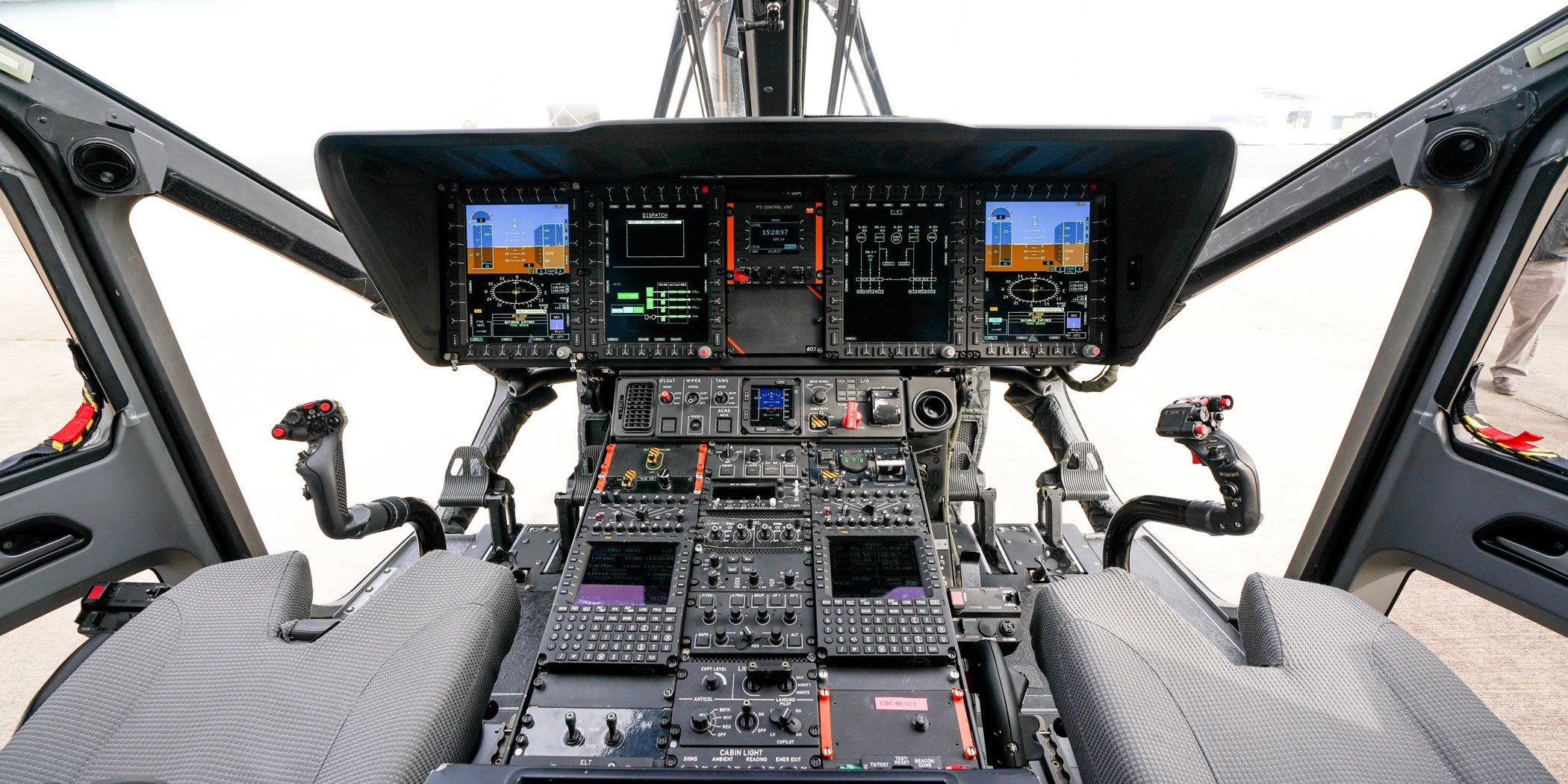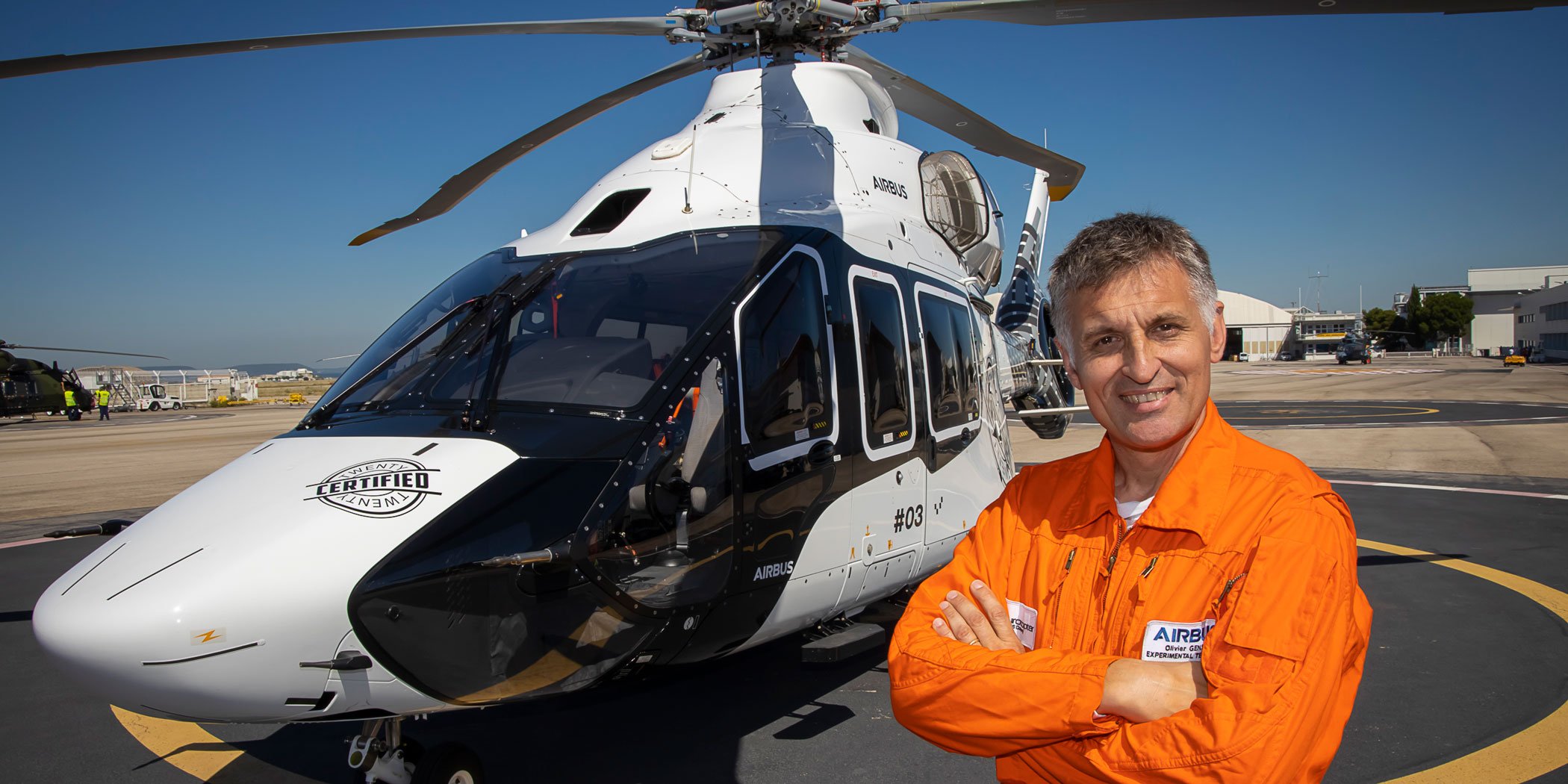Airbus Helicopters did more than create a new aerodynamic design for the H160 medium twin-engine helicopter; it also changed how pilots fly the unique new machine. While Airbus didn’t opt for costly and complex fly-by-wire, the H160’s full-time autopilot (or automatic flight control system or AFCS) offers many similar benefits to fly-by-wire flight controls.
Airbus calls the new design “accrued pilot assistance” and it includes flight envelope protection, all with the goal of helping pilots stay out of trouble or—if they do get into trouble—fix the problem before loss of control results in an accident.
That isn’t to say that the pilot doesn’t have full control over the H160 at all times. But the automation is there for a reason and also carefully thought out from the perspective of a human-machine interface.

Olivier Gensse, Airbus’s H160 experimental flight test pilot, was instrumental in the design and testing of the H160’s AFCS. “I hope it will be a big step for us too,” he said. “We spent a lot of energy to find a new answer for incidents and accidents. Most are linked to human factors, and it was a big part of our innovation to try to develop automation that is more simple and intuitive for pilots with less experience.”
The H160, which is equipped with Airbus’s Helionix avionics package with weather radar, synthetic vision, moving map, TCAS II, and HTAWS, builds on the H175’s automatic airspeed and flight path stability. That makes flying the H160 much easier and allows the pilot to attend to other tasks without worrying about ending up in an unusual attitude. Also known as a fly-through autopilot, the AFCS remains on all the time in the H160. In hands-on mode, the pilot can make the H160 do anything the helicopter can do, but the autopilot is still on. With hands off the controls, that just results in the helicopter maintaining the same flight path and airspeed.
This key feature fits with Airbus’s philosophy of making its helicopters easier to fly and requiring less training. But at the same time, Airbus designers paid a lot of attention to the flight deck design. The goal was to remove and simplify the controls, switches, and knobs, Gensse explained. That allowed designers to improve the pilot’s field of view for looking outside but also helps lower the number of pilot actions required, which benefits training and safety. “With less actions, there are less mistakes, but you also save time,” he said.
Gensse likes to demonstrate how the design improves the pilot and passenger experience, going from dark cockpit to engine startup and ready for takeoff in less than two minutes. “Everything is automatic,” he said. “It’s positive automation. You can follow everything, and it’s easy to understand. But if there is any discrepancy, you have feedback or an alert.” If there is nothing wrong, then the system doesn’t bother the pilot with unnecessary information.
The Outside View
The design further helped expand the pilot’s outside view, by reducing the space needed for instrumentation and displays. “Because we don’t have oil pressure [and] temperature showing all the time, we have space to present safety information like TCAS, nav, etcetera,” he said. “For the internal part, you have all the information that you need and a very large field of view from your feet to the roof to have an opportunity to see the external view. This is a very new concept philosophy and hard to build. It cost a lot in terms of design.”
Although engine instruments aren’t always front and center, the system manages any applicable limitations and alerts the pilot if there is an issue. “You can fly the H160 with no engine instruments in front of you,” he said. “If you have a discrepancy, you have an alert and have time to manage that.”
If there is a failure, the H160 automatically reconfigures the system appropriately instead of waiting for the pilot to run through steps in a checklist. The pilot still has full control of the systems, if preferable. But the workload is much lower when the helicopter automatically takes care of the problem. “It takes five to ten seconds to achieve every procedure,” he said. “It’s very efficient and easy.”
Although touchscreens are becoming widespread in aircraft, the H160 sticks with traditional displays surrounded by configurable keys. Helicopter vibration has always been an issue for touchscreens, but the H160’s lower vibration levels would easily allow touchscreens, Gensse said. “I think we will [eventually] have touchscreens,” he added.

During takeoff, the dual-autopilot AFCS provides an automatic assisted takeoff function, which can be done with hands off the controls. While it can be a lot of work to calculate the safest trajectory for takeoff, the automatic system monitors rotor rpm and the flight path to ensure a safe outcome in case of failure of one of the H160’s two Safran Arrano engines. The system can even help land the H160 safely after engine failure while in a hover, automatically selecting the power needed on the remaining engine.
In cruise, if an engine fails, the H160 AFCS reduces speed to maintain the flight path, giving the pilot plenty of time to evaluate the situation, brief passengers, plan a diversion, or try a restart. “Everything is managed,” Gensse said, “and the workload is very low.”
Although demonstrated during certification testing, a dual engine failure is a very low probability event, he explained. “What is good about that compared to other helicopters is that it is easy to manage rpm, there is a lot of inertia in the rotor system. This is good because you have time to manage the trajectory.” Due to the low probability of dual engine failure, Airbus didn’t automate the autorotation process—although that could be done—so the pilot still has to manage rotor rpm.
Like other modern helicopter autopilots, the H160 has a recovery mode. This is activated by double-clicking a button on the cyclic and automatically brings the H160 to straight-and-level configuration. If flying close to the ground and experiencing a visibility-reducing phenomenon like a dusty brownout or snowy whiteout, the pilot can simply double-click the button and the H160 will revert to a safe hover.
With a full-time AFCS, there is no so-called “wet noodle” mode where the pilot can opt to fly fully manually, although Airbus has demonstrated what happens if the AFCS isn’t operating. “The autopilot is always on,” Gensse said. “It’s part of our design philosophy, to try to build the most stable aircraft we could, with the best handling qualities. But with two autopilots, that failure never happens.”
Vortex Prevention
Airbus added a significant new safety feature that is unique to the H160, a vortex pre-alerting system designed to give pilots advance notice that the helicopter is about to enter a dangerous vortex ring state. “This gives a five- to seven-second warning,” he said, “enough time to change the condition.”
Vortex ring state, also known as settling with power, is not only hard to detect when it is happening, it’s impossible to demonstrate safely. “We expect this will change the point of view to vortex ring state,” Gensse said.
The system provides both an audible and visual alert to “check power.” The pilot can either add power, if sufficient margins are available, or if already at maximum power, try to fly out of the condition. Another option is to push the go-around button on the collective, which will fly the H160 out of the vortex ring state in the most efficient way possible.
“Vortex ring state is not so big an issue to manage if you have altitude,” he explained. “When we did the tests, we were at high altitude with lots of time to recover. The problem in operational life is that most time is spent close to the ground. Vortex ring state might have a descent rate of 3,000 feet per minute, and that’s not enough time to get out. It’s important to have pre-alerting.”
The pre-alerting system “is quite a complex equation,” he said, “but it takes into account deceleration, the level of power, and the total energy picture.” A high rate of deceleration without extra energy available from the engine signals likelihood of vortex ring state, for example. A challenge in developing this system was to eliminate a high rate of false alerts. “The secret is to have the alert only when you will encounter it,” he said. “For a long time, we’ve wanted to implement it, and we’re happy to have certified that.”

Preventing Loss of Control
The design philosophy of the H160 AFCS is that the autopilot is always on and will always try to assist. “Whatever the condition, the autopilot will be on and will try to help you,” Gensse said. “If you are out of the normal flight envelope, the autopilot will try to recover to go inside the envelope. For the pilot, he doesn’t have to think, ‘can I use it?’ Don’t ask questions, just use it.”
For that reason, there are no limitations beyond which the autopilot will just give up flying and hand an out-of-control helicopter back to the pilot. It will take longer to recover from more extreme conditions, Gensse explained, “but the aircraft is recovering in the most efficient way. If it’s close to the ground and nose down and full speed, the limit is physics; if the aircraft is able to recover, it will. If it’s too extreme an attitude, it will try, but if not possible, then it can’t do it. We didn’t want to put limits for recovery because every time you can use it, the autopilot will do its best.”
The H160 isn’t designed to eliminate the need for piloting skill, but to enhance the pilot’s skills without adding to the workload. If an unexpected event happens, pilots typically aren’t ready, but as Gensse explained, “you have a lot of direct access to help you. It’s easy to use in a normal way and easy during an event.
“You can train a lot and use a simulator to become the best pilot,” he added, “but we prefer to have not much training required to achieve the best level. Safety is the first priority. Each time we can improve safety, it’s better.”
That said, Airbus doesn’t intend to lower the training requirements for such a capable helicopter. “My philosophy is to keep the same volume of training because of innovation,” he explained. “We want to be sure the customer is comfortable with all that automation. Automation is good if you understand it.”
H160 pilot training will take place at Airbus’s Marignane facility in France, where the first H160 simulator was certified by EASA in August. FAA certification of the simulator is expected at the end of this year. A second simulator is planned for the U.S.
Helionix and the dark cockpit concept are not new for Airbus Helicopters; these are also implemented on the H175 and H145. Some of the H160 features will likely be made available on other helicopters, such as the vortex pre-alerting and assisted takeoff. The family concept will already help because H175 pilots will need just two flights to transition into the H160.
“What is impressive for the new H160 pilot is the external visibility,” he said. “This is the first time in that size helicopter that you can have such visibility...and comfort. There is no vibration; it’s a really pleasant aircraft.”
When pilots fly the H160 for the first time, Gensse said, “everybody can understand it’s really an improvement. When we see the pilot’s smile at the end of the flight, it’s really nice for the team. We all worked for one thing: that smile.”







